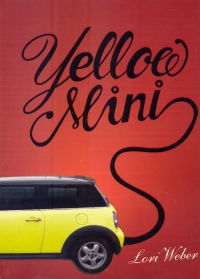| ________________
CM . . . . Volume XVIII Number 11 . . . . November 11, 2011
excerpt:
Adolescent readers, but especially females, may already know Lori Weber as the author of several novels in Lorimer’s “Side Streets” series. With Yellow Mini, Weber changes both publisher and literary genre. Yellow Mini, a most engaging free verse novel, introduces readers to four 16-year-olds and one 17-year-old who all attend the same high school. Annabelle, Stacey and Mary have been friends for 10 years, ever since grade one, but this school year has brought changes to their friendship. Over the summer holidays, Stacey had discovered “boys” and the power of flirting, and she has utilized her new found skill to land popular 17-year-old Mark, the owner of the yellow Mini Cooper. This conquest allows Stacey both to join the in-crowd who hang out in the school’s third floor lounge and to abandon her “loser” friends. The book’s fifth character is the academically bright, but shy, Christopher who, up until now, has had an unvoiced crush on Annabelle. Though Weber gives all of the book’s characters their own individual voices, Annabelle gets to “speak” almost twice as often as the novel’s other teens. Annabelle is the daughter of an unwed mother who works in real estate, and having observed how her mother has compromised to be “a woman surviving in a man’s world”, Annabelle states, “[T]hat’s not the kind of life I want: corporate.” Something else that Annabelle doesn’t want for her life: “I don’t want to be ordinary.” Part of Annabelle’s not being ordinary this year involves her becoming the sixth member of the Social Action Group, an extracurricular activity that has Mr. Dawe, one of the book’s eight adult characters, as its teacher coordinator.The third girl is the social isolate Mary whose passion is the solitary activity of playing piano, especially classical pieces. Mary’s immediate challenge is determining whether or not to risk “outing” her passion by auditioning for the school’s annual talent show. The novel’s two adolescent males are opposites in a number of ways. Mark, who had failed a grade, is at the top of the school’s social ladder while Christopher is one of the school’s techie geeks. Every month, Mark seemingly has a new girl in his yellow Mini (a secondhand vehicle purchased with his father’s insurance money), with Stacey being Mark’s newest piece of eye candy. On the other hand, Christopher, until now, has never even approached a girl. In an attempt to get closer to Annabelle, Christopher becomes the Social Action Group’s seventh member, and he participates in their social awareness events at the local mall where the group distributes pamphlets relating to the exploitation of child labour in Third World Countries. Initially too shy to share directly how he feels about Annabelle, Christopher slips an unsigned love poem into Annabelle’s pocket at one of the events [see “excerpt” above], later confessing that he was its author. The first romance for both Annabelle and Christopher goes well until Christopher admits that he does not fully share Annabelle’s enthusiasm for the Social Action Group’s public activities. Mark, who appears to have it all, but especially socially, is actually the least together of this adolescent quintet. The son of Lebanese immigrants, Mark fought with his taxi-driver father who wanted Mark to fulfill the immigrant dream - a university degree, a well-paying job, a good wife and family. However, the memory that Mark carries with him is that of the last argument he had with his father, one in which his father contrasted Mark’s wastrel behaviour with that of Mark’s future-focussed cousins in Beirut. That same day, Mark’s father was killed in a traffic accident, and Mark says: What makes Yellow Mini truly so different from most other YA novels is that Weber provides the book’s eight adult characters with their own voices as opposed to just having readers see them through their adolescent children’s eyes. In addition to Mr. Dawe, all of the teens’ parents (with the exception of Christopher’s mother) speak directly to readers, though collectively their 19 total entries are similar in number to just one of the adolescent’s. Nonetheless, these adult entries effectively show the parents’ concern about their children’s present situations and futures as well as offering admissions about some of the adults’ failures, both as parents and during their own adolescent years. Each of the poems, which range in length from a single page to four pages, is given a title which is followed by the name of the “speaker” [see the “excerpt” above]. Mary’s titles are always a musical term (such as “Doloroso ma sognado) which is followed by the term’s English translation (Sorrowful but dreamy). As well, Mary’s entries are consistently printed on a grey background. Another design feature is that the titles for each speaker are rendered in a font unique to that person. In a classroom situation, the reasons for both of these design features could form the starting point for a lively discussion. A quick read, Yellow Mini is an outstanding character study in which the book’s adolescents are seeking to discover and form their individual identities. Though the book comes to an “ending,” readers will recognize that the characters’ “stories”, while completed to this point in time, are certainly far from being over. One of this year’s must-buy books! Highly Recommended. Dave Jenkinson, CM’s editor, lives in Winnipeg, MB.
To comment
on this title or this review, send mail to cm@umanitoba.ca.
Copyright © the Manitoba Library Association. Reproduction for personal
use is permitted only if this copyright notice is maintained. Any
other reproduction is prohibited without permission.
NEXT REVIEW |
TABLE OF CONTENTS FOR THIS ISSUE
- November 11, 2011.
AUTHORS |
TITLES |
MEDIA REVIEWS |
PROFILES |
BACK ISSUES |
SEARCH |
CMARCHIVE |
HOME |
